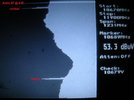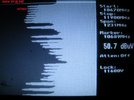You are using an out of date browser. It may not display this or other websites correctly.
You should upgrade or use an alternative browser.
You should upgrade or use an alternative browser.
Astra 2F Testing Reception Reports
- Thread starter Analoguesat
- Start date
- Status
- Not open for further replies.
Huevos
Satellite Freak
- Joined
- Sep 11, 2008
- Messages
- 6,038
- Reaction score
- 1,277
- Points
- 113
- My Satellite Setup
- 57E to 58W, C-band and Ku, DVB-S2, 4:2:2 and blindscan.
- My Location
- 38.5ºN, 0.5ºW
What can't you see? 11643h? It's still active. It just pops out of the noise for about 0.25 second every 10 or 15 seconds. Easy to catch with a device with real time spectrum and peak hold.i not see that
maybe spot beam ?
Nothing on 11711H for me right now.
gonzobaby
Regular Member
- Joined
- Oct 11, 2012
- Messages
- 61
- Reaction score
- 23
- Points
- 8
- My Satellite Setup
-
100cm Gibertini OP100XL
Inverto Black Ultra Quad
Vantage HD8000S
Technotrend S2-3600
- My Location
- Schoeningen, Germany
Solly, if you would know how many Turksat signals you are receiving... you could save a lot of your posts !
gonzobaby
Regular Member
- Joined
- Oct 11, 2012
- Messages
- 61
- Reaction score
- 23
- Points
- 8
- My Satellite Setup
-
100cm Gibertini OP100XL
Inverto Black Ultra Quad
Vantage HD8000S
Technotrend S2-3600
- My Location
- Schoeningen, Germany
now i got 12515h very strong
look at the frequency table of Turksat and let me know if you noticed something...
Huevos
Satellite Freak
- Joined
- Sep 11, 2008
- Messages
- 6,038
- Reaction score
- 1,277
- Points
- 113
- My Satellite Setup
- 57E to 58W, C-band and Ku, DVB-S2, 4:2:2 and blindscan.
- My Location
- 38.5ºN, 0.5ºW
terryashbyash
Member
- Joined
- Jan 21, 2005
- Messages
- 121
- Reaction score
- 27
- Points
- 28
- Age
- 66
- My Satellite Setup
-
skybox F3 for fta/28.2E
inverto black ultra lnb
1m offset
- My Location
- Gandia, Spain
Looks interesting as your location not far from me, I know it is too early to judge but questionsOk, here are a couple of screenshots.
First, 10754V on Astra 2F @ 43ºE.
Second, 10758V on Astra 1N @ 28ºE for level comparison using the same aerial.
1. Do you know if it PE or UK spot?
2. Is it aerial or dish/lnb, I really don´t know if other aerials work at these frequenicies, lost above 1 GHz on this front,
- Joined
- Jul 26, 2003
- Messages
- 51,123
- Reaction score
- 11,570
- Points
- 113
- Location
- Scottish Borders
- My Satellite Setup
-
TM 5402HD
Sky+ UK.
- My Location
- Scottish Borders
Looks interesting as your location not far from me, I know it is too early to judge but questions
1. Do you know if it PE or UK spot?
No real way to tell. All the info about beams on these threads are guesswork, nothing more.
Huevos
Satellite Freak
- Joined
- Sep 11, 2008
- Messages
- 6,038
- Reaction score
- 1,277
- Points
- 113
- My Satellite Setup
- 57E to 58W, C-band and Ku, DVB-S2, 4:2:2 and blindscan.
- My Location
- 38.5ºN, 0.5ºW
Solly, I don't know the duration of this test. It may just have been active for a matter of seconds. We had people around for the afternoon and I just left the meter running for a few hours on peak-hold and this is what it caught in that time.i not receiver this signal it no much strong
Only SES know that. As AS says predicting which beam this is would be complete guesswork. To map a beam properly we would need a stable signal, and a large number of stations across Europe able to submit signal reports. And that's not going to happen until the satellite starts transmitting DVB-S modulated signals that a wider audience are able to receive.1. Do you know if it PE or UK spot?
A dish/LNB is an aerial, isn't it?2. Is it aerial or dish/lnb
hvdh
Specialist Contributor
- Joined
- Dec 10, 2004
- Messages
- 2,379
- Reaction score
- 3,376
- Points
- 113
- Age
- 60
- Website
- gso-satellites.nl
- My Satellite Setup
- Dr.HD F16, TBS 5927, T-55, Laminas 120 cm
- My Location
- Oss, NL (5.5°E 51.8°N)
terryashbyash probably means, it is possible that some local transmitter got into your coax cabling. That thought also crossed my mind.A dish/LNB is an aerial, isn't it?
10754 - 9750 = 1004 MHz. These kind of frequencies may be used by (illegal) video transmitters.
DECT telephones are also known for causing interference.
You may try to disconnect the LNB and just hang a short piece of wire to the coax core (carefully of course)!
Some possibly interfering spectrum peaks will appear, and maybe a few funny constellation diagrams as well.
Huevos
Satellite Freak
- Joined
- Sep 11, 2008
- Messages
- 6,038
- Reaction score
- 1,277
- Points
- 113
- My Satellite Setup
- 57E to 58W, C-band and Ku, DVB-S2, 4:2:2 and blindscan.
- My Location
- 38.5ºN, 0.5ºW
What I posted is coming from the satellite, that is certain.terryashbyash probably means, it is possible that some local transmitter got into your coax cabling. That thought also crossed my mind.
Terry's question was in response to my comment in post #611.
Huevos
Satellite Freak
- Joined
- Sep 11, 2008
- Messages
- 6,038
- Reaction score
- 1,277
- Points
- 113
- My Satellite Setup
- 57E to 58W, C-band and Ku, DVB-S2, 4:2:2 and blindscan.
- My Location
- 38.5ºN, 0.5ºW
Solly, you've lost me here.i receuver l band 1090 and 1120 db up signal
short pick signal
- Status
- Not open for further replies.




